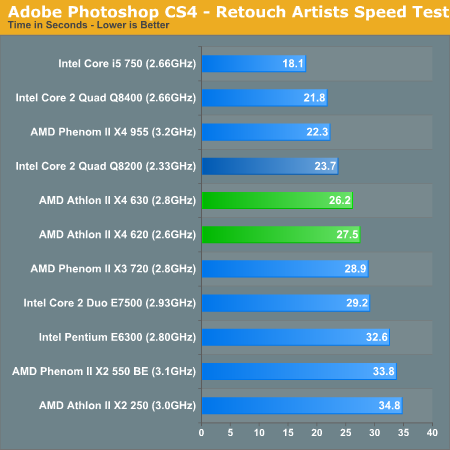AMD Athlon II X4 620 & 630: The First $99 Quad Core CPU
by Anand Lal Shimpi on September 16, 2009 12:00 AM EST- Posted in
- CPUs
Adobe Photoshop CS4 Performance
To measure performance under Photoshop CS4 we turn to the Retouch Artists’ Speed Test. The test does basic photo editing; there are a couple of color space conversions, many layer creations, color curve adjustment, image and canvas size adjustment, unsharp mask, and finally a gaussian blur performed on the entire image.
The whole process is timed and thanks to the use of Intel's X25-M SSD as our test bed hard drive, performance is far more predictable than back when we used to test on mechanical disks.
Time is reported in seconds and the lower numbers mean better performance. The test is multithreaded and can hit all four cores in a quad-core machine.

Photoshop performance is actually very good on these chips, the extra cores help make them faster than even a Phenom II X3 720. For $99 you're getting better Photoshop performance than even more expensive dual core processors.
The Pentium E6300 isn't competitive here, despite being Intel's closest priced processor. The Q8200 is faster than both of these options, but it's also more expensive. Again, AMD priced the 620 on point.










150 Comments
View All Comments
Eeqmcsq - Wednesday, September 16, 2009 - link
The L2 cache in the Athlon II X4s are the same as the Phenom II X4, 512KB per core, 2MB total. It is only on the Athlon II X2s that the cache was doubled to 1MB per core, 2MB total.TA152H - Wednesday, September 16, 2009 - link
Oh, OK. I guess I should actually read the charts.Thanks.
Hmmmmm, I wonder why they overclock so poorly. It doesn't make much sense. You'd think it would use less power, and generate less heat. Strange.
Anand Lal Shimpi - Wednesday, September 16, 2009 - link
Two options: 1) New die, takes time to get the mix perfect for better yields/higher clock speeds, or 2) the chip isn't using super high frequency/high leakage transistors to maximize performance. It could be designed to hit lower frequencies.Take care,
Anand
Eeqmcsq - Wednesday, September 16, 2009 - link
The skeptic in me says bad design problems, like the first Phenoms. That could also account for the multiple delays and pushbacks on the Athlon X4s. But in all seriousness, I have no idea.Eeqmcsq - Wednesday, September 16, 2009 - link
Found this on another site. Perhaps you can check and confirm:"...the imprint "AADAC” identifies the CPU as a Propus."
Anand Lal Shimpi - Wednesday, September 16, 2009 - link
My 620 is an AADAC while my 630 is an AACYC. I will ask AMD to confirm :)Take care,
Anand
Anand Lal Shimpi - Wednesday, September 16, 2009 - link
Spoke with AMD this morning. The OPN does not indicate whether or not the chip has a disabled L3. It's just luck of the draw, there's no way to tell by looking at the chip itself.Take care,
Anand
Doormat - Wednesday, September 16, 2009 - link
Please upgrade to a more modern x264 benchmark. I'd recommend a recent handbrake snapshot (http://handbrake.fr/snapshot.php)">http://handbrake.fr/snapshot.php). The nehalem optimizations should boost performance dramatically and are a better representation of what people would get with current encoders.Anand Lal Shimpi - Wednesday, September 16, 2009 - link
I agree completely, the question is more one of when we make the transition. There's a lot of historical data we need to compare to. You'll see a slow transition to new tests especially with the final version of Windows 7.Take care,
Anand
Lunyone - Wednesday, September 16, 2009 - link
Finally we have quad cores at about $100!! Hope that this will spur on better pricing on all fronts! Go AMD, we need the competition to drive down better pricing. Now only if you would drop down the PhII x4 955/965 pricing to compete better with the i5 750!!